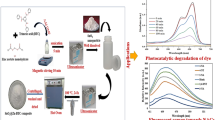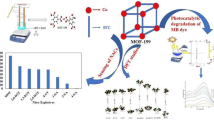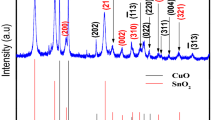Abstract
A novel SnO2@Cu3(BTC)2 composite was synthesized using a quick and affordable bottom-up approach via impregnation of SnO2 nanoparticles into the porous Cu3(BTC)2 metal-organic framework (MOF). This composite material is characterized by Fourier transform infrared (FTIR) spectroscopy, powder X-ray diffraction (PXRD) spectra, scanning electron microscope (SEM) analysis, and energy-dispersive X-ray spectroscopy (EDS) analysis. SnO2@Cu3(BTC)2 degraded the methylene blue (MB) dye within 80 min under sunlight with a maximum degradation efficiency of 85.12%. This composite easily recyclable up to five cycles with the retention of its MB degradation efficiency. Moreover, SnO2@Cu3(BTC)2 can be also used efficiently for fast sensing of 2,4,6-trinitrophenol (TNP) in water with noticeable turn-off quenching response. Its limits of detection (LOD) for TNP was 2.82 µM with enhanced selectivity toward TNP (over other NACs) as verified by competitive nitro explosive tests. Density functional theory (DFT) calculations and spectral overlap were used to assess the sensing mechanism. This composite fluorescent sensing system for TNP are demonstrated to have high selectivity and sensitivity. Our findings imply that the prepared low cost SnO2@Cu3(BTC)2 composite can be used as a superior fluorescence sensor and photo catalyst for large scale industrial applications.
Graphical Abstract





















Similar content being viewed by others
Data Availability
Data and material information is provided and will be shared on request.
References
Li H, Eddaoudi M, O’Keeffe M, Yaghi OM (1999) Design and synthesis of an exceptionally stable and highly porous metal-organic framework. Nature 402(6759):276–279
Farha OK, Hupp JT (2010) Rational design, synthesis, purification, and activation of metal− organic framework materials. Acc Chem Res 43(8):1166–1175
Dong JP, Shi ZZ, Li B, Wang LY (2019) Synthesis of a novel 2D zinc (II) metal–organic framework for photocatalytic degradation of organic dyes in water. Dalton Trans 48(47):17626–17632
Pan Y, Ding Q, Xu H, Shi C, Singh A, Kumar A, Liu J (2019) A new Zn (ii)-based 3D metal–organic framework with uncommon sev topology and its photocatalytic properties for the degradation of organic dyes. Cryst Eng Comm 21(31):4578–4585
Fei H, Shin J, Meng YS, Adelhardt M, Sutter J, Meyer K, Cohen SM (2014) Reusable oxidation catalysis using metal-monocatecholato species in a robust metal–organic framework. J Am Chem Soc 136(13):4965–4973
Chen YZ, Zhang R, Jiao L, Jiang HL (2018) Metal–organic framework-derived porous materials for catalysis. Coord Chem Rev 362:1–23
Maina JW, Pozo-Gonzalo C, Kong L, Schütz J, Hill M, Dumée LF (2017) Metal organic framework based catalysts for CO 2 conversion. Mater Horiz 4(3):345–361
Herm ZR, Wiers BM, Mason JA, van Baten JM, Hudson MR, Zajdel P, ... Long JR (2013) Separation of hexane isomers in a metal-organic framework with triangular channels. Science 340(6135):960–964
Liang B, Zhang X, Xie Y, Lin RB, Krishna R, Cui H, ... Chen B (2020) An ultramicroporous metal–organic framework for high sieving separation of propylene from propane. J Am Chem Soc 142(41):17795–17801
Pan L, Olson DH, Ciemnolonski LR, Heddy R, Li J (2006) Separation of hydrocarbons with a microporous metal–organic framework. Angew Chem Int Ed 45(4):616–619
Sun Y, Zheng L, Yang Y, Qian X, Fu T, Li X, ... Tan W (2020) Metal–organic framework nanocarriers for drug delivery in biomedical applications. Nano-Micro Lett 12(1):1–29
Cai W, Wang J, Chu C, Chen W, Wu C, Liu G (2019) Metal–organic framework-based stimuli-responsive systems for drug delivery. Adv Sci 6(1):1801526
Lei J, Qian R, Ling P, Cui L, Ju H (2014) Design and sensing applications of metal–organic framework composites. TrAC Trends Anal Chem 58:71–78
Fang X, Zong B, Mao S (2018) Metal–organic framework-based sensors for environmental contaminant sensing. Nano-Micro Lett 10(4):1–19
Tajik S, Beitollahi H, Nejad FG, Kirlikovali KO, Van Le Q, Jang HW, ... Shokouhimehr M (2020) Recent electrochemical applications of metal–organic framework-based materials. Cryst Growth Des 20(10):7034–7064
Yang W, Li X, Li Y, Zhu R, Pang H (2019) Applications of metal–organic-framework-derived carbon materials. Adv Mater 31(6):1804740
Wen X, Zhang Q, Guan J (2020) Applications of metal–organic framework-derived materials in fuel cells and metal-air batteries. Coord Chem Rev 409:213214
Li R, Chen T, Pan X (2021) Metal–organic-framework-based materials for antimicrobial applications. ACS Nano 15(3):3808–3848
Miyasaka H (2013) Control of charge transfer in donor/acceptor metal–organic frameworks. Acc Chem Res 46(2):248–257
Walker AM, Civalleri B, Slater B, Mellot‐Draznieks C, Corà F, Zicovich‐Wilson CM, ... Gale JD (2010) Flexibility in a metal–organic framework material controlled by weak dispersion forces: the bistability of MIL‐53 (Al). Angewandte Chemie 122(41):7663–7665
Zhang M, Xiao C, Yan X, Chen S, Wang C, Luo R, ... Li J (2020) Efficient removal of organic pollutants by metal–organic framework derived Co/C yolk–shell nanoreactors: size-exclusion and confinement effect. Environ Sci Technol 54(16):10289–10300
Yu J, Mu C, Yan B, Qin X, Shen C, Xue H, Pang H (2017) Nanoparticle/MOF composites: preparations and applications. Mater Horiz 4(4):557–569
Zlotea C, Campesi R, Cuevas F, Leroy E, Dibandjo P, Volkringer C, ... Latroche M (2010) Pd nanoparticles embedded into a metal-organic framework: synthesis, structural characteristics, and hydrogen sorption properties. J Am Chem Soc 132(9):2991–2997
Jiang HL, Akita T, Ishida T, Haruta M, Xu Q (2011) Synergistic catalysis of Au@ Ag core− shell nanoparticles stabilized on metal− organic framework. J Am Chem Soc 133(5):1304–1306
Hermes S, Schröter MK, Schmid R, Khodeir L, Muhler M, Tissler A, ... Fischer RA (2005) Metal@ MOF: Loading of highly porous coordination polymers host lattices by metal organic chemical vapor deposition. Angewandte Chemie Int Ed 44(38):6237–6241
Schröder F, Esken D, Cokoja M, Van Den Berg MW, Lebedev OI, Van Tendeloo G, ... Fischer RA (2008) Ruthenium nanoparticles inside porous [Zn4O (bdc) 3] by hydrogenolysis of adsorbed [Ru (cod)(cot)]: a solid-state reference system for surfactant-stabilized ruthenium colloids. J Am Chem Soc 130(19):6119–6130
Ishida T, Nagaoka M, Akita T, Haruta M (2008) Deposition of gold clusters on porous coordination polymers by solid grinding and their catalytic activity in aerobic oxidation of alcohols. Chem–A European J 14(28):8456–8460
Ishida T, Kawakita N, Akita T, Haruta M (2010) Deposition of gold clusters onto porous coordination polymers by solid grinding. In Studies in Surface Science and Catalysis (Vol 175, pp 839–842). Elsevier
Wang B, Liu W, Zhang W, Liu J (2017) Nanoparticles@ nanoscale metal-organic framework composites as highly efficient heterogeneous catalysts for size-and shape-selective reactions. Nano Res 10(11):3826–3835
Kumar P, Kim KH, Lee J, Shang J, Khazi MI, Kumar N, Lisak G (2020) Metal-organic framework for sorptive/catalytic removal and sensing applications against nitroaromatic compounds. J Ind Eng Chem 84:87–95
Vikrant K, Tsang DC, Raza N, Giri BS, Kukkar D, Kim KH (2018) Potential utility of metal–organic framework-based platform for sensing pesticides. ACS Appl Mater Interfaces 10(10):8797–8817
Jagan Mohan Reddy A, Katari NK, Nagaraju P, Hussain Reddy K, SurendraBabu MS (2021) Fabrication and deployment of nanodisc ZnO@ ZIF-8, ZnO@ NA and ZnO@ INA core–shell MOFs: enhanced NH3 and HCHO gas sensing. J Mater Sci: Mater Electron 32:7827–7840
Koppula S, Jagasia P, Surya SBM (2023) MOF (M= Zr, Zn, Co)@ COFs hybrid composite as a potential adsorbent for UO22+ and Methylene blue (MB) from solutions. Mater Today Commun 34:105336
Koppula S, Manabolu Surya S, Katari NK, Dhami PS, Sivasankaran Nair RK (2022) Mesoporous MOF composite for efficient removal of uranium, methyl orange, methylene blue, and Congo red dyes from aqueous solutions. Appl Organomet Chem 36(3):e6554
Archana K, Pillai NG, Rhee KY, Asif A (2019) Super paramagnetic ZIF-67 metal organic framework nanocomposite. Compos B Eng 158:384–389
Mahmoodi NM, Abdi J (2019) Nanoporous metal-organic framework (MOF-199): Synthesis, characterization and photocatalytic degradation of Basic Blue 41. Microchem J 144:436–442
Arenas-Vivo A, Rojas S, Ocaña I, Torres A, Liras M, Salles F, ... Horcajada P (2021) Ultrafast reproducible synthesis of a Ag-nanocluster@ MOF composite and its superior visible-photocatalytic activity in batch and in continuous flow. J Mater Chem A 9(28):15704–15713
Abdelhameed RM, Tobaldi DM, Karmaoui M (2018) Engineering highly effective and stable nanocomposite photocatalyst based on NH2-MIL-125 encirclement with Ag3PO4 nanoparticles. J Photochem Photobiol A 351:50–58
Lu H, Zhang L, Wang B, Long Y, Zhang M, Ma J, ... Ni Y (2019) Cellulose-supported magnetic Fe3O4–MOF composites for enhanced dye removal application. Cellulose 26(8):4909–4920
Ren J, Wu YZ, Dai Y, Sha DW, Chen M, Wang JJ, ... Yan XH (2017) Enhanced visible-light-driven photocatalytic activity of CeVO4/graphitic C3N4 photocatalysts for organic dye degradation. Mater Technol 32(9):574–583
Amini A, Kazemi S, Safarifard V (2020) Metal-organic framework-based nanocomposites for sensing applications–A review. Polyhedron 177:114260
Acknowledgements
One of the author, Deepika is grateful to University Grants Commission (UGC), New Delhi, India, for providing junior research fellowship.
Funding
The authors did not receive support from any organization for the submitted work and have no financial or non- financial interests to disclose.
Author information
Authors and Affiliations
Contributions
Deepika: Performed the experimentation. Heena and Manpreet Kaur,: Helped in performing the experiments. Karamjit Singh Dhaliwal and Ashok Kumar Malik: Helped in writing and supervised the research work.
Corresponding author
Ethics declarations
Ethics Approval
There are no ethic approvals required for this research work.
Consent to Participate
All authors will participate in the revision of the manuscript.
Consent for Publication
All authors agree for the publication.
Conflicts of Interest
All the authors declare that there is no conflict of interest.
Additional information
Publisher's Note
Springer Nature remains neutral with regard to jurisdictional claims in published maps and institutional affiliations.
Highlights
• Using a bottom-up approach, a unique SnO2@Cu3(BTC)2 composite has been prepared.
• Experiments demonstrate that this composite degrade 85.12% of methylene blue (MB) dye within 80 minutes.
• Additionally, this composite also sensitively and selectively detects 2,4,6-trinitrophenol (TNP) in water via turn-off quenching response.
• The turn-off quenching response of this composite can be explained by photo-induced Electron Transfer (PET) and fluorescence Resonance Energy Transfer (FRET) mechanisms.
• Theoretical density functional theory (DFT) calculations were done to provide strong support to the experimental results.
Rights and permissions
Springer Nature or its licensor (e.g. a society or other partner) holds exclusive rights to this article under a publishing agreement with the author(s) or other rightsholder(s); author self-archiving of the accepted manuscript version of this article is solely governed by the terms of such publishing agreement and applicable law.
About this article
Cite this article
Deepika, Heena, Kaur, M. et al. Novel SnO2@Cu3(BTC)2 Composites as a Highly Efficient Photocatalyst and Fluorescent Sensor. J Fluoresc 33, 2415–2429 (2023). https://doi.org/10.1007/s10895-023-03232-0
Received:
Accepted:
Published:
Issue Date:
DOI: https://doi.org/10.1007/s10895-023-03232-0




